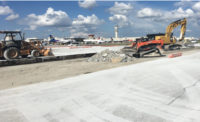Airports Emphasize Flexibility In New Designs
Still, Airport Improvement Program funding is "pretty flat," Gu adds. Despite years of industry efforts, passenger facility charges (PFCs) remain stuck—much like the federal fuel tax that funds surface transportation—at $4.50. "At some large airports, some PFCs are pledged for over 30 years in order to finance projects already under way," she adds.
Although the Port Authority of New York & New Jersey recently solicited P3 teams for the $3-billion redevelopment of LaGuardia Airport's central terminal, Gu says, "we haven't seen a lot of uptake in the U.S. market for it."
On the other hand, design-build, construction manager-at-risk and other project delivery methods are increasing on U.S. projects, says Loren Smith, AECOM global aviation-sector leader. "It took somewhat longer in aviation [than in highway and transit] to catch on, but it's much more common now," Smith notes.
Building-information-modeling and geographic-information-system tools are gaining in use and life-cycle management is emphasized more, Smith adds. "After surveys and designs are completed, we're reusing the data as an asset management tool. This is not [common] yet. It does take more care and thought up front," Smith says.
Such data might also help airport designers respond to how passengers check in, check bags and create checks at restaurants and other concessions. "Builders have to stop looking at the same designs we used 15 to 20 years ago," says William Fife, an airport consultant. "Design-wise, you need more open spaces. You have to calculate passenger processing rates differently. Technology designers and engineers all have to work together."


